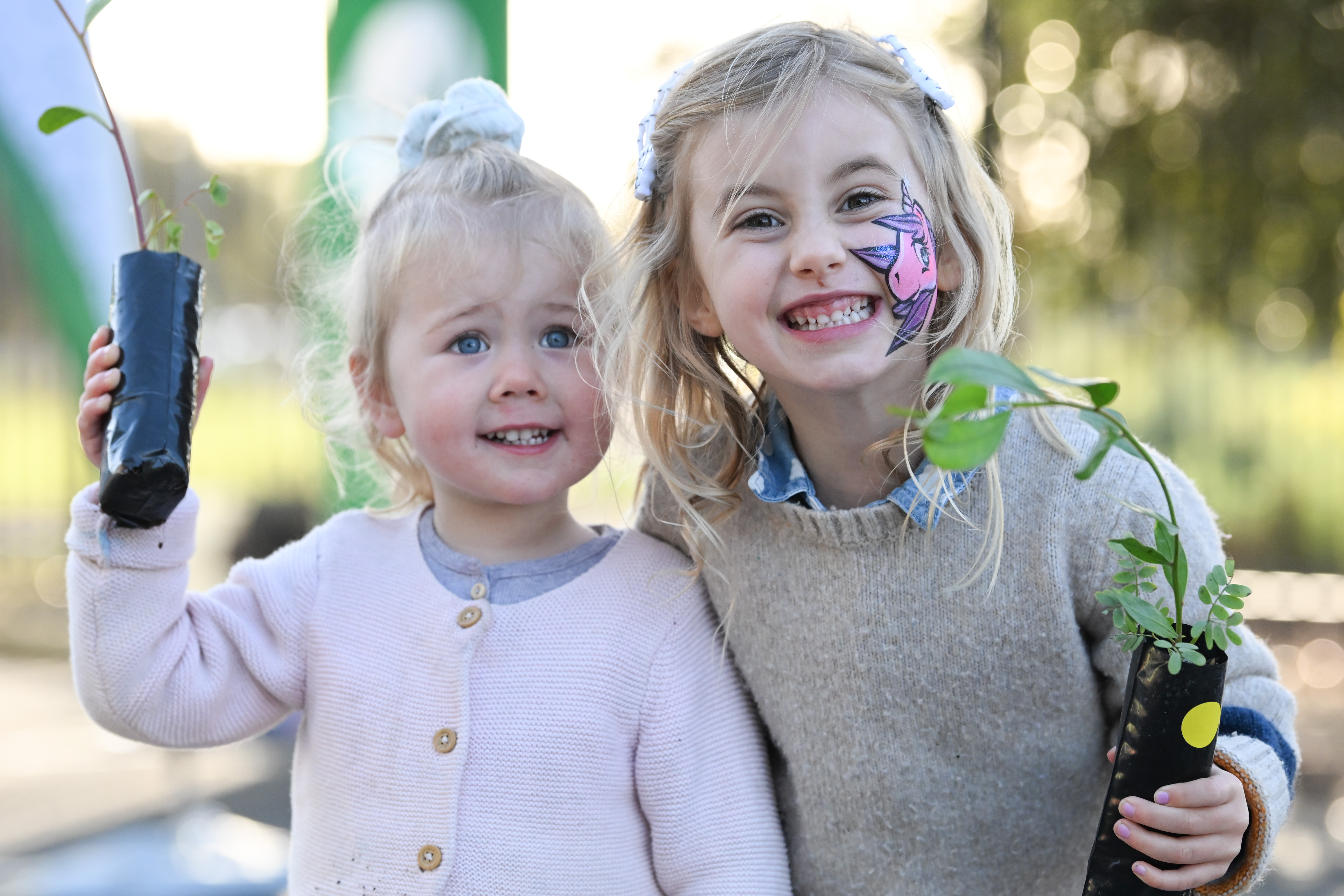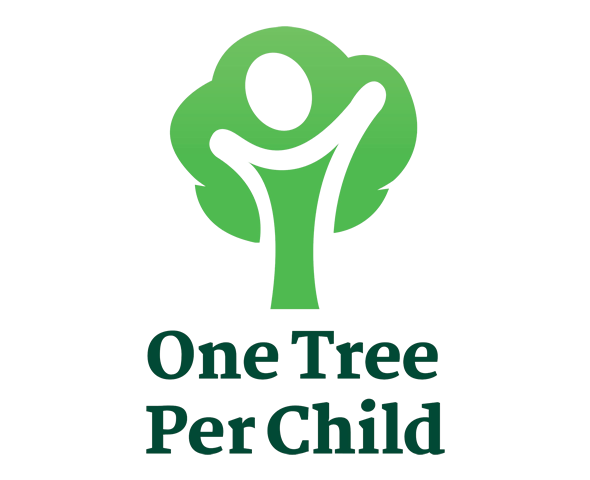Whether it’s in your backyard, with your local community group, at a business, or even at school, planting a tree is as easy as One, Two, Tree!
Why plant trees? Our region has some hot spots, and by planting more trees, we can help cool things down for everyone. Plus, by greening our spaces we're creating wonderful habitats for pollinators like bees and butterflies! With 74% of Onkaparinga being privately owned land, it’s up to all of us to pitch in and make a change!
Community tree giveaway events
Every June, we host a community tree giveaway as part of a fun-filled family day for Onkaparinga residents. In 2026, we’ll once again partner with Trees For Life and Arborgreen to bring this much-loved event to life. This year’s giveaway took place on Sunday, 15 June at the Aldinga Community Centre.
The 2025 event was a huge success – with 2,000+ people joining us for a fun-filled afternoon of information stalls, kids activities, and crowd-favourite entertainment from the Amazing Drumming Monkeys!
We gave away 1,200 tubestock trees to both pre-registered participants and those who took a chance on the day, hoping to snag one. These trees will now be planted across the 74% of Onkaparinga’s land that’s privately owned – helping pollinators thrive and making our region greener and cooler for years to come.
The trees were grown for us by Onkaparinga local Trees for Life volunteers using remnant seed, so they’re well-suited for our region’s drier conditions. At the event, those collecting trees were also gifted Arborgreen tree stakes and guards to help protect their tubestock when planted.
Keep your eyes pealed for information on our June 2026 event, once details are finalised.
If you missed out on a free tree this year, don’t worry! You can still find helpful information below on choosing the best tree for your garden and be sure to watch our video for expert planting tips to ensure you succeed.
For the most up to date information on this project follow Sustainable Onkaparinga on Facebook or keep an eye on our website and publications. To speak to someone about our giveaway events contact Tracy Fulton, Sustainability Education Coordinator via email or 8384 0666.

Missed out on a free tree this year or looking to add more? Aim for diversity. The more different size and type of trees and shrubs you plant the better. Nature thrives on diversity and diverse gardens are happy gardens.
Local native trees and shrubs are a great low maintenance option for your garden. Adelaide’s native trees have adapted to survive our hot summers and wet winters – and generally need minimal TLC.
Adelaide’s local natives are Australian trees that are native to this area. They are native trees suitable for and found in Adelaide’s environment. If you’re thinking a different species – originating elsewhere in Australia, or overseas – just make sure they aren’t considered a weed in South Australia.
Check out SA’s declared pest plants, and get to know our emerging weeds by looking at the ‘what not to plant' sections of the Green Adelaide coastal and Adelaide gardens planting guides. There's also a handy Garden Guide for New Homes and renovations.
Declared and environmental weeds pose a major threat to the health of our natural environment. You can also use the Plant Selector+ tool to help your choose the right trees and shrubs for the right places.
Watch our video for expert planting tips to ensure your new tree thrives.
If you aren't able to access free trees via our annual tree school or community programs - you can visit your local gardening shop for a browse of different trees species.
For local native trees and shrubs, the best bet is to visit a native plant grower/nursery.

Early learning centres and schools located within City of Onkaparinga can apply annually for free trees and shrubs but first need to be part of Green Adelaide's Sustainable Schools program.
The Green Adelaide southern education team, hosted within Council, can provide expert species advice, help with your planting event and a combined education offering that is linked to the curriculum and EYLF for the very best student outcomes.
If you're not already part of the program, it's easy to join! Click here to find out more and then reach out to the southern team.
In 2024, the team helped fourteen lucky local schools to plant 520 trees and shrubs in their school grounds. This year, another fourteen schools have planted 550 trees and shrubs.
Many schools choose for their younger students to take part, enabling them to watch their planted tree grow over their time at the school. Creating a legacy in nature is special and vitally important - as confirmed when we overheard two of the students chatting whilst planting - “I haven’t done this before. It’s fun. In 10 years time I’m going to come back and check on my tree”. Heart-warming!

Pollinators are like nature’s little superheroes—buzzing around, doing their thing, and making the world a better place! From busy bees to butterflies, these tiny powerhouses are responsible for helping plants grow, thrive, and produce the food we love. Without them, our gardens would be a lot less colourful, and our plate of fruit would look pretty bare! So, let’s give a round of applause to these winged wonders - helping to create healthy ecosystems, one buzz at a time!
While we often focus on European honeybees, birds and butterflies, there is a much wider range of pollinators, many of them native and all equally important. Many insect pollinators have wings and fly from plant to plant increasing the number of plants they can visit and pollinate. They include everyday flies, hover and droneflies, bee flies, scorpion flies, wasps, native bees, ants, mosquitoes, thrips, beetles, jewel beetles, grasshoppers and katydids, and bugs. As well as insects, birds, possums and bats pollinate plants.
More than 65% of plants in Australia are dependent on pollinators. The rest including grasses, cycads and pines depend on the wind and water for dispersal of pollen. Some cycads and pines also depend on insect pollinators. Pollinators are attracted to plants by scent and visual cues like colour. Some pollinators are generalists, moving between plant species, while others are specialists using a few species of plant. Some pollinators are also more effective than others. The blue-banded bee and teddy bear bees buzz pollinate flowers, vibrating the pollen from the flower.
By planting pollinator-friendly trees, like those we offer at our tree giveaways you're helping pollinators thrive in your garden and beyond.

Photo: Rob Wallace
South Australia has some great areas of natural bush which are home to our own unique plants and animals. But as our cities have grown, these spaces are increasingly being developed, reducing vegetation cover and pushing our wildlife into smaller areas.
Key areas of protected vegetation are fragmented and often cut off from one another. Private landholders including home gardens and schools can help to expand these areas by planting local native plants which serve as stepping stones within the landscape and contribute to much-needed habitat.
It’s important to note that revegetation and habitat creation are not only available to those who own or manage large areas of land which can sometimes be a misconception. Home gardens, schools and community spaces can all contribute to creating habitat, improving biodiversity and supporting wildlife individually and by connecting to larger habitat corridors already established across the landscape.
Creating and contributing to habitat corridors supports the movement of species to access resources and contributes to the resilience of the landscape. You don’t need a big area to make an impact locally, you can plant one or two local native tree(s) in your garden along with some good native understory shrubs, grasses and ground cover species which can all help provide food and shelter to wildlife and contribute to the overall revegetation of your local area.
While having protected and well-managed larger areas of habitat is critical, there is no need to rely solely on existing protected areas or to leave it to landholders with larger properties to safeguard our biodiversity. We can all play a part.
When multiple home gardens on a street make this commitment, they create a larger connected area between themselves. When schools, community groups and businesses approach their landscaping with habitat in mind, land that is typically under-utilised becomes full of life. In all cases, we learn the value of our local native plants and wildlife, of tending to something with care and patience and the importance of diversity in sustaining a balanced environment.
Imagine the impact if every home, school, business and community space was thriving with a diverse range of native species. What would it mean for our local wildlife, for our environment and for ourselves.
TREES FOR LIFE

Trees For Life is one of South Australia’s oldest and most loved not-for-profit environmental organisations. Every year they train and work with thousands of dedicated volunteers, along with their project staff, to deliver on-ground conservation and revegetation programs across South Australia.
ARBORGREEN

Arborgreen is an Australian, family-owned and run business. They sell products and materials for tree establishment and care. If the right product doesn’t exist, they will invent it! They are passionate about educating our youth in working towards a greener future.
GREEN ADELAIDE

Green Adelaide are South Australia's first government urban environmental organisation. Their work is unique as it delivers environmental outcomes amidst urbanisation, and embeds Kaurna traditional practices in delivery. Their area of responsibility spans across Adelaide’s 17 metropolitan councils and includes about a third of Gulf St Vincent.
Green Adelaide's southern education team are hosted within the City of Onkaparinga's Environmental Sustainability team.
ONE TREE PER CHILD

We thank One Tree Per Child for their involvement during our 2024-2025 two-year pilot program. Their participation supported local engagement and contributed to community outcomes during this period. As we shift to a more localised model in 2026, we appreciate the role they played in helping lay the groundwork.
Our 2025 tree giveaway at the Aldinga Community Centre was a huge success! Now, those trees are being planted by local residents, community groups, and small businesses across our region. Check out the map to see where they’re taking root - are you one of these locations?